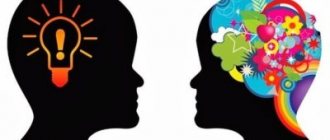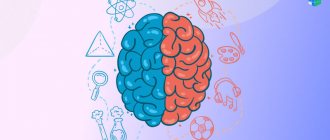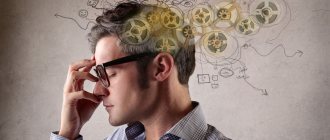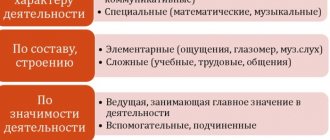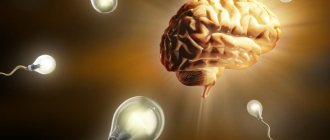Article:
Intelligence... With this word, many of us feel a kind of pride, since it is known that a person possesses it to the highest degree. Some even think that intelligence is something that only humans have. We will have to disappoint them: animals also have intelligence. Some even try to speculate about its presence in plants and other groups of organisms, but so far this has not gone beyond the bounds of science fiction. Recently, developments in the field of artificial intelligence have achieved great results.
What is intelligence
Intelligence is the mental ability of the body, expressed in the ability to solve various problems, cope with problems, carry out cognitive activity, adapt to changing environmental conditions and manage it.
Intelligence is manifested in educational, research, work activities, communication and social life in general. This concept unites individual cognitive abilities: sensations, perception, memory, ideas, thinking, imagination, will, reflection, attention.
The concept of intelligence arose relatively recently - only at the end of the nineteenth century. At that time, psychology was developing at a rapid pace, and researchers were studying the mental abilities of humans and animals. Sometimes they made serious mistakes. Thus, at that time, the prevailing belief was that a person uses only a few percent of his brain, while the rest of it remains unused. In everyday life, this idea still persists, but it is fundamentally incorrect and was refuted by science a long time ago. But how could such an assumption even arise? The fact is that at the end of the nineteenth century the functions of a significant part of the brain were not yet studied, and researchers could not understand what they were needed for. In addition, some processes in the brain occur as if in an automatic mode, without the participation of human consciousness. That is, it seems to us that some part of the brain is inactive, but in fact it carries out extremely important work unnoticed by us, without which, probably, intelligence itself would become impossible.
However, the issue of the relationship between intelligence and the brain is quite complex. Does man have intelligence? Of course there is. But does a cat have it? Probably there is too. What about the lizard? One might think that she has it too. What about an ant, a microbe, a plant? At first glance, it seems that the more developed the organism, the more we can talk about the presence of intelligence. But here, too, not everything is so simple.
Ants, like all other insects, do not have a brain at all. Their "brains", dispersed throughout the body, are a primitive nerve cluster. And the entire structure of the ant organism is very primitive. Meanwhile, some even seriously compare the intellectual abilities of ants with those of humans. Ants can accumulate and transmit information, communicate, learn, and they have a complex hierarchy. They can navigate the terrain; recent research shows that they apparently can even count. In ant society there are many “professions”, the variety of which varies for each species. In fact, the life of an anthill is very reminiscent of human society.
A lizard is an organism of a completely different kind. Its overall development is tens of times more complex and organized than that of an ant. And there is a full-fledged brain, and a fairly developed one at that. But the intellectual abilities of a lizard are very modest and cannot be compared with the intelligence of an ant (and even more so a human).
It turns out that intelligence is more of a function than a certain material structure. Intellectual activity can be realized in various ways.
How is this function implemented? The implementation of an intellectual function occurs through the work of its components: this is the ability to find connections between disparate data, synthesize and analyze, compare, classify, build associations, etc. Each such ability separately does not form intelligence, it can only be discussed in the aggregate of these abilities .
Features of the human intellectual system consist of several parameters:
- Working memory capacity, ability to predict, use tools, logic;
- Multi-level hierarchy of selection of valuable information - six layers of neurons are involved in this;
- Consciousness;
- Memory.
Intelligence does not appear suddenly and on its own, but develops over time. The intellectual level of a person can be increased through special techniques; it can also decrease due to various circumstances (old age, head injuries, mental illness, etc.).
Abilities and Intelligence
The problem of abilities and intelligence in modern society goes beyond narrow professional psychological problems and acquires social significance. On the one hand, it underlies a person’s self-determination, his self-realization, often causing both intrapersonal and interpersonal conflicts and creating tension in the event of non-realization of certain abilities. On the other hand, it provides society’s need for labor resources whose orientation and qualifications correspond to the stage of development at which society is located. The relationship between these two sides of one problem also conceals many conflicts, since the needs of society for certain types of activities and a person’s abilities for them often do not coincide.
abilities represent the main condition for the effectiveness of his implementation of a particular activity. Abilities are discovered in the process of activity, and in this regard, experts distinguish two sides of abilities: passive - until a person begins an activity, it is impossible to judge the presence of abilities, active - something prompts a person to engage in a certain type of activity. Closely related to the latter is the concept of inclinations towards certain types of activities. A.V. Orlov believes that inclination should be understood not as any, but as a well-defined, internally motivated predisposition to activity, when not only the goals achieved are attractive, but also the process of activity itself. Addiction acts as a “need attitude” towards an activity to which a given person is particularly partial. V.N. Myasishchev notes such a feature of the inclination as tireless attention to the chosen activity, unquenchable love for it, this undying passion
Specific features of the tendency of E.P. Ilyin denotes as follows: a) as an incentive to activity, the inclination always corresponds to the content of the activity (it is internally motivated by its content, type of activity; for example, when choosing a sport, the inclination to work of an “explosive” nature leads to sprinting, the inclination to various activities, to playing sports games, etc.); b) addiction is most often determined by stable typological features of the properties of the nervous system, the level of brain activation, it is a stable vector for choosing the type of activity; c) activity in accordance with inclination is always personally significant, occupies an important place among a person’s values, contributes to the formation of the personality’s orientation, a certain vision of the world; d) the inclination, when choosing an activity adequate to it, develops into persistent interest; e) in the absence of activities that correspond to the inclination, a person becomes bored and dissatisfied with his activities. Consequently, it can be assumed that in conditions of non-realization of a person’s inclination towards a certain type of activity, negative reactions are possible, and since nature does not tolerate emptiness, the place of boredom and dissatisfaction can be taken by socially disapproved manifestations of personality. Therefore, in the consulting process, it is of particular importance to assist the client in the timely identification of certain abilities and the development of a strategy for their implementation.
There are general and special abilities. General abilities are relatively stable personality properties, which are manifested in the success of mastering knowledge, in mastering and implementing various types of activities. Special abilities are personality traits that allow one to achieve significant results in a particular type of activity.
General abilities include cognitive, or mental, psychomotor and spiritual. Psychomotor abilities are manifested in the implementation of sensorimotor processes and motor actions. The main indicators of psychomotor abilities are: speed, strength, tempo (number of movements in a certain period of time), rhythm, coordination, accuracy and ease, plasticity and ease.
Spiritual abilities represent the individual uniqueness of a person’s mental processes, manifested in relation to the surrounding world, to the problems of surrounding people. There are such spiritual abilities as empathy, compassion, the ability to self-knowledge and self-awareness, the ability to see the beautiful, reflect the harmony of the objective world, the ability to be grateful and do good. The criterion of spiritual abilities is action.
Cognitive abilities are a tool of human cognitive activity and cognitive activity. These include abilities associated with the level of development of cognitive mental processes: perception - perceptual abilities, memory - mnemonic, attention - attentional, thinking - mental, imagination - imaginative abilities. The totality of cognitive abilities constitutes the basis of intelligence.
V.N. Druzhinin proposed to consider general abilities as an integral work of the psyche in operating with knowledge. In this process, he highlighted knowledge acquisition, knowledge application and knowledge transformation (Figure 2.1).
| Operating with knowledge | Acquisition of knowledge | Knowledge transformation | Application of knowledge |
| Capabilities | LEARNING ABILITY | CREATIVITY | INTELLIGENCE |
| Motivation | Cognitive activity | Self-actualization and creative activity | Achievement motivation and adaptability |
Rice. 2.1. Scheme of general abilities according to V.N. Druzhinin
Learning ability characterizes the ability to acquire knowledge and the leading motivation for this process is a person’s cognitive activity (“I want to know everything”). Creativity is characterized by the ability to transform knowledge and is associated with imagination, the generation of hypotheses, and a tendency to fantasize. The leading motivational direction for its implementation is the desire for self-realization and creative activity. The ability to apply knowledge, as an output characteristic in this scheme, is identified with the ability to solve problems based on existing knowledge, or intelligence . The leading motivation in the implementation of intellectual abilities is achievement motivation and adaptive behavior in the environment.
All the identified types of general abilities largely correlate with each other, but, of course, there is no complete correspondence. A person who has a pronounced ability to acquire knowledge, which is confirmed by academic performance, is not always able to apply his knowledge in real life (“excellent student syndrome”), a high level of intelligence does not yet indicate a person’s creative capabilities, the ability to find a new, non-standard solution. In this discrepancy in the expression of different types of abilities lie many social problems of clients: the holder of a “honorable diploma” may be unable to solve practical problems in work, a pronounced intellectual may lose to people with a lower level of intelligence, but with creative abilities. Such inconsistencies lead a person to internal conflicts (high level of aspirations and low level of achievements, unjustified expectations), the collapse of life plans and, as a result, a negative attitude towards life.
The ability to learn is quite clearly manifested in the process of learning activities. Learning success can be predicted by studying the level of development of cognitive mental processes (perception, attention, memory, imagination, thinking) using age-appropriate test methods. In case of problems associated with learning, it is recommended to use techniques to develop these processes. Thus, for the development of attention and memory, the method of developing eidetic memory has proven itself well.
The problem of intelligence is currently the most controversial and worries, as already mentioned, not only specialists, but also the general public. The use of intellectual tests that reveal individual differences in abilities thereby differentiates people into those who are more capable and those who are less capable. Such differentiation in the modern world has serious consequences and is associated with significant ethical problems. Even La Rochefoucauld once sarcastically about.
The term “intelligence,” in addition to its scientific definition, which also today largely depends on the theoretical positions of a particular author, according to V.N. Druzhinin, “like an old cruiser with shells, has become overgrown with an endless number of everyday and popular interpretations.” Currently, there are two main approaches to defining intelligence: 1) intelligence is what intelligence tests measure; 2) intelligence is what ensures effective adaptation in a complex environment.
The measurement approach to determining intelligence has a long tradition. Its essence lies in the design of tasks: the level of intelligence is determined on the basis of the success of solving various types of problems, close to those that a person solves in everyday life. A supporter of this approach is G. Eysenck. The disadvantage of this approach is the fact that modern intelligence tests use not only a ratio scale, which assumes an absolute reference point, but also an interval scale, which does not have an absolute reference point.
It is impossible to define intelligence outside of the diverse forms of interaction between an individual and the environment. Therefore, the definition of intelligence through adaptive activity is finding more and more supporters. In line with this direction, intelligence is defined as a certain ability that determines the overall success of a person’s adaptation to new situations by solving a problem on the internal plane (“actions in the mind”) with the dominant role of consciousness over the unconscious.
Currently, there are a large number of intelligence tests, the structure and content of which are largely based on the theoretical views of their authors on the understanding and structure of intelligence. The Raven's Progressive Matrices test, based on Spearman's theory, which distinguishes the G-factor as a general ability and factors of specific abilities, reveals the level of development of the general G-factor. The Wechsler test also diagnoses general intelligence (G-factor) and its components - verbal and non-verbal intelligence.
G. Eysenck's extra-factor model of intelligence also belongs to the school that emphasizes the importance of the G-factor. Based on his model, G. Eysenck developed a battery of intellectual tests aimed not only at determining the client’s IQ, but also allowing work on the development of intellectual abilities, which is especially important for counseling.
The model proposed by R. Cattell can also be classified as a hierarchical model. In the concept of R. Cattell, the G-factor consists of two common factors - fluid
(“free”) intelligence and
crystallized
, or “coherent” intelligence. Crystallized intelligence evaluates the totality of knowledge and intellectual skills acquired by an individual in the process of socialization, and is a measure of mastery of the culture of the society to which the individual belongs. Fluid or “free” intelligence, according to R. Cattell, is independent of involvement in culture; its level is determined by the general development of the “tertiary” associative zones of the cerebral cortex and manifests itself when solving perceptual problems (when the subject is required to perceive and find the ratio of elements) . To measure fluid intelligence, R. Cattell developed a culturally free intelligence test. It is known that while fluid intelligence declines with age, crystallized intelligence remains intact in the later stages of life. Knowing this fact is very important when counseling on the problems of old age.
Tests of the structure of intelligence are based on the model of L. Thurstone, who denied the existence of a common basis for intellectual actions and identified several unrelated intellectual factors (spatial thinking, computational abilities, verbal abilities, etc.). Among the most used tests of the structure of intelligence in Russia is the R. Amthauer test.
J. Guilford's three-dimensional model of intelligence is also close to the factor model. In the model he developed, each factor of intelligence is formed by a combination of one of the types of intellectual operations, the area in which it is performed (content), and the result obtained. Guilford distinguishes five types of operations , constituting the first change in his model: understanding information
(C),
memorization
(M),
divergent thinking
, or production of logical alternatives related to the presented information, multivariate search for a solution to a problem (D),
convergent thinking
, or production of a single logical consequence, search for one correct solution (N) and
evaluation
- comparison and evaluation of information units according to a certain criterion (E).
The second dimension is defined in terms of the content and forms of information: figurative
(F),
symbolic
(S),
semantic
(M) and
behavioral
(B).
The third dimension represents the result of applying a certain intellectual operation to specific content and appears in the form of: elements, units
(U),
classes
(C),
relations
(R),
systems
(S),
transformations
(T) and
implications
(I). Thus, the existence of 120 intelligence factors is assumed. Thanks to the research of J. Guilford, the term “social intelligence” has gained true reality, characterizing the integral intellectual ability that determines the success of communication and social adaptation; he developed a test for the study of social intelligence.
Guilford's great merit is also the identification of divergent and convergent thinking. Convergent thinking is aimed at finding a single correct result and is diagnosed by traditional intelligence tests, while divergent thinking is associated with the generation of many solutions based on unambiguous data and is the basis of creativity. of creativity became widespread . Test materials are being developed to study creativity, but the validity of most currently available creativity tests has not been proven. To identify creativity, the so-called natural tasks (writing poetry, stories, assembling a mosaic, etc.), as well as the biographical method, are more suitable. Personal characteristics of creative people were identified, such as attaching high value to aesthetic qualities, breadth of interests, energy, independence of judgment, autonomy, self-confidence, the ability to resolve paradoxes or reconcile clearly opposing conflict elements.
An analysis of the biographies of creative personalities shows that creative abilities are more often developed among the first-born in the family and children who lost their parents early. In addition, creativity is associated both with heredity and with the regulation of the environment: the less regulated the child’s environment, the greater the chance of creativity in his activities.
When consulting creative individuals, it should be taken into account that creativity requires a relaxed, free environment. In addition, many studies show that strong motivations for achievement, social approval, and competitive motivation block the self-actualization of the individual and make it difficult to demonstrate creative abilities.
Four groups of children with different levels of development of creativity and intelligence were identified, differing in their ways of adapting to external conditions and solving life problems (Druzhinin). Children with high intelligence and high creativity
, were confident in their abilities, had an adequate level of self-esteem, had internal freedom and at the same time high self-control.
Showing great interest in everything new and unusual, they have great initiative and maintain personal independence of judgment and action. Children with a high level of intelligence and low creativity
strive for school success, experience failure extremely hard, and are dominated not by the hope of success, but by the fear of failure. They avoid risk, are reserved, secretive, do not like to express their thoughts publicly, and distance themselves from their classmates. They have few close friends. They do not like to be left to their own devices and suffer without external adequate assessment of their actions, results, and activities.
Children with low intelligence but high creativity
often find themselves in a “outcast” situation.
They have difficulty adapting to school requirements and often have outside interests (clubs, hobbies, etc.). They are more anxious, suffer from a lack of self-confidence and an inferiority complex. Teachers often characterize them as dull and inattentive because they are reluctant to complete routine tasks and cannot concentrate. Children with a low level of intelligence and creative abilities
outwardly adapt well, stay in the “middle class”, have adequate self-esteem and are satisfied with their position. The low level of subject abilities is compensated by the development of social intelligence and sociability.
What types of intelligence are there?
A major researcher in the field of intellectual development, Raymond Cattell, believed that intelligence should be divided into two types - mobile and crystallized. The first is based on logical operations, the ability to solve problems that go beyond the limits of existing experience. The second is based on accumulated experience and the ability to use existing knowledge and skills.
There is also a division into emotional and social intelligence. The first is the ability to recognize and understand your own emotions and the emotions of those around you. The second type is the ability to understand people's behavior. Social intelligence is the most important part of a person’s social life; it allows you to interact with other people and build various relationships. Researchers emphasize that the purpose of such intelligence is not depth of understanding, but social adaptation.
The diversity of types and forms of intelligence can be judged, for example, by the cultural characteristics of different peoples. For example, the Negroid race has the most highly developed concrete visual and plastic thinking. The people of Africa are good artists and excellent dancers; they can depict by hand what Europeans are accustomed to depicting only with the help of computer graphics. Drawing and dance in Africa play the role of original “alphabets” from which special languages are composed. European thinking is abstract. Painting and dance in European culture are considered an art, that is, a skill accessible to few; at the same time, the sound-letter alphabet, reasoning in abstract categories, understanding of such phenomena as law, justice, order, etc. are developed. The Asian peoples of the Mongoloid race are carriers of “symbolic” thinking. Their symbolic (hieroglyphic) alphabet and system of allegories have reached a high level of development; the culture is replete with symbols that lack practical meaning and express complex ideas, and rituals and ceremonies play a significant role in behavior.
There are other ways to divide intelligence. Thus, they distinguish between logical and spatial intelligence, and the latter is divided into physical, social, spiritual, creative, and emotional.
Theories
The main theories of intelligence existing in psychology:
- General intelligence. Charles Spearman, a British psychologist, conducted several experiments to test intellectual abilities using tests. According to his findings, people who pass one test are more likely to pass others. Low results on one test were combined with low results on others. Therefore, he believed that intelligence is a holistic cognitive skill that can be measured using special tests. His ideas were extremely popular in the twentieth century.
- Primary intellectual abilities. The creator of this idea is Louis Thurstone, who worked in the first half of the twentieth century. According to his theory, human intelligence consists of seven primary skills, including understanding of verbal information, verbal fluency, and associative memory.
- Multiple intelligences. This theory was created by Howard Gardner. He developed eight types of intelligence, which were discussed in detail in the section “Types of intelligence in psychology.” G. Gardner actively criticized ideas that were popular in the twentieth century, closely associated with IQ tests, and his theory is an attempt to explain the versatility of intelligence.
- Three-component theory of intelligence. This theory was created by Robert Sternberg. He came up with a list of skills that, in his opinion, are part of the so-called “successful intelligence.” There are three factors of intelligence: component, practical and creative.
Also significant are the studies of Jean Piaget, a famous 20th century psychologist who is the creator of the theory of cognitive development.
According to his ideas, a person goes through three stages in his intellectual development, gradually improving and becoming more complex. He considers formal logical thinking to be the highest mental ability.
Piaget's ideas mainly related to childhood and adolescence. He developed a theory of children's intellectual skills, and, according to it, children think no worse than adults, not more primitively, but differently. Their intelligence has individual characteristics.
Jean Piaget also wrote a book, “The Psychology of Intelligence ,” in which he talks in detail about how intellectual abilities and thinking work.
Levels of intellectual activity
There is such a thing in psychology as levels of intellectual activity.
Researchers identify three such levels:
- Stimulus-productive – when mental activity is caused only by the influence of external factors.
- Heuristic is a spontaneous cognitive activity that leads to the discovery of a number of patterns.
- Creative is the highest level of mental activity, at which there is a full penetration into the essence of the things being studied, solving existing problems and setting new tasks.
At the first level, intellectual activity is limited to a given or initially found path. A person can study various phenomena and solve various problems, but only as private ones, without connection with each other. At this level, however, the intellectual can put forward quite bold hypotheses.
At the second level, the researcher can compare disparate phenomena and problems and find something in common in them, identify new patterns. In this case, knowledge occurs empirically.
At the third level, comparing different phenomena and finding what they have in common becomes not just a separate technique, but is itself a problem that requires deep insight into the essence of things. In this case, the researcher uses the theoretical path of knowledge.
Intellectual actions of an individual are divided into levels in another way.
In this case, there are two levels:
- Personal actions at the level of a social individual, while human activity is determined by the task and desired results.
- Actions of a creative person; in this case, the result turns out to be broader than the stated goal and gives rise to new tasks.
The activity of the individual gradually ceases to be a response to the initially set task and takes on a creative character.
The division of the work of the intellect into levels also reflects the history of the development of mental activity in humans. That is, the first people passively solved the problems facing them, formed by nature itself, and strived for biological survival; knowledge was more of an adaptive nature. Subsequently, primitive “scientific” activity appeared, when, through searches, trial and error (empirically), people found new patterns in the structure of the surrounding world and tried to use them in their practice. Finally, at the very latest time, a theoretical science was formed that had a developed methodological apparatus and deep criteria for knowing the truth.
For clarity, you can also use Maslow’s famous pyramid, which reflects the hierarchy of human needs. It shows that the need for creativity and spiritual development is the highest, and to achieve it you need to go through lower levels. In accordance with this, the intellect works: at first it is aimed at achieving pressing goals and solving specific problems (finding food, housing, achieving material well-being), then opportunities arise for learning something new, and at the highest level the opportunity arises for creative activities.
Intellectualization in psychology
Intellectualization is one of the forms of psychological defense in which a person closes himself off from his sensory sensations and begins to perceive what he feels on an intellectual level. This helps reduce the influence of emotions on behavior and decisions, and act more wisely and correctly.
But any protective mechanisms of the psyche negatively affect how an individual perceives reality and himself . In this case, intellectualization leads to the fact that the individual ceases to realize the importance of his emotional state.
People who actively use such defenses have difficulty expressing emotions , which complicates interaction with others, especially in the case of close social relationships (love, friendship).
It is considered an integral part of the personality of schizoids (both schizoid accentuation and schizoid personality disorder are implied).
Read about the symptoms and treatment of emotional personality disorder here.
Intelligence quotient: methods of determination
Intelligence quotient - the famous IQ - determines the degree of development of a person’s mental activity. It is sometimes used to evaluate the mental abilities of animals in comparison with humans. Researchers have even determined the IQ of creatures such as the earthworm.
The coefficient is determined using special tests that allow you to find out various factors, for example:
- Level of intelligence development in comparison with the average person (of the same or middle age);
- The “intellectual age” of a person in comparison with his biological age;
- The presence or absence of mental pathology.
Creating IQ tests is a rather difficult task. Their results should be described by the so-called “normal distribution” of indicators, or Gaussian distribution. This means that 50 percent of people would have an IQ between 85 and 115, and 25 percent of people would have an IQ below 90 and above 110. An IQ value of less than 70 is defined as mental retardation.
Who introduced the concept of intelligence?
The mental abilities of people have been the subject of study by many scientists, including famous thinkers of Ancient Greece and Ancient Rome. However, the concept of intelligence was first introduced only at the end of the 19th century, that is, a little more than a hundred years ago.
The term “intelligence” was coined by the British anthropologist Francis Galton. He was inspired by the work of Charles Darwin and was a proponent of Darwin's theory of evolution. By the way, Francis Galton's subject of interest was not only the intellectual abilities of people, but also their genome.
Francis Galton
In an effort to benefit humanity, the scientist became the founder of eugenics - a doctrine aimed at combating degeneration. This teaching was later used by Adolf Hitler to explain the goals and benefits of Nazism.
However, Francis Galton himself did not seek to destroy defective people. In his opinion, an intellectual person should be comprehensively developed, including spiritually. The scientist himself fully corresponded to this description, having made significant contributions to the development of psychology, genetics, criminology and physics. Later, his views on the essence of intelligence were confirmed by other researchers who classified the intellectual abilities of people.
What factors influence a person's mental abilities?
The level of intelligence can vary significantly among different people. Among us there are intellectuals, slow-witted people, people with average abilities and those who are commonly called mentally retarded. But why are people so different mentally?
Various studies have shown that the formation of human mental abilities is influenced primarily by genetic factors. Upbringing, environmental influences and random external influences play a much smaller role.
However, the external environment also has a certain significance for the formation of intelligence. These are factors such as the standard of living of the family, the level of education of parents, the nature of upbringing, the availability of school education for children (in American studies, students from good urban schools turned out to be more intellectual than students from modest rural schools). Research has even established the influence of such individual factors as annual family income, the size of the house and its cost, the relationship between parents, etc.
The role of nutrition cannot be ruled out. The brain is a rather voracious structure, and a lack of nutrients can lead to a decrease in its ability to process information.
Odds information
Contrary to popular belief, it is extremely difficult to measure intelligence because, as mentioned, it consists of many different abilities.
And even existing tests created by famous psychologists cannot be considered an ideal measurement method: they often measure only some of the components of intelligence.
They are convenient to use to identify people with insufficient intellectual abilities, which helps in diagnosing some diseases, but they are difficult to find geniuses with their help, since genius is also a complex structure consisting of many components.
The most well-known tests that reveal IQ are:
- Hans Eysenck test;
- Raven's test (Raven);
- Wechsler test.
Tests showing IQ levels have been repeatedly criticized by various researchers, for example, mathematician Viktor Vasiliev, who found errors in the Eysenck questionnaire.
It has also been noted that IQ level weakly correlates with the likelihood that a person will achieve success in life and be happy.
The type of intelligence that can be measured using the above tests is called psychometric . Its manifestations are quite simple to identify and record.
Data:
- It is extremely important that a person at the formation stage (during pregnancy and childhood) receives a sufficient amount of iodine . The average IQ in regions where children and pregnant women do not receive enough iodine is 10-15 points lower than in regions where this problem does not exist.
- People with a high IQ are more likely to suffer from mental illness , especially anxiety disorder.
- Marilyn vos Savant is an American woman with the highest IQ in the world: 228. She is a journalist and writes books.
The degree of development of emotional intelligence (EQ) is of great importance. People with developed EQ find it easier to interact with others, adapt in society and achieve success at work.
Differences in the intellectual development of men and women
Since ancient times, society has been dominated by the view of women as inferior beings and less developed than men. Traditions and laws that do not allow women to engage in certain types of activities have led to the emergence of the myth that women's intelligence is developed significantly lower than men's. Because of this, it was believed that a woman should “know her place” and not interfere in “men’s affairs,” otherwise nothing good will come of it.
The easing of the position of women and their equal rights with men have shown that women's intelligence is in no way inferior to men's. Moreover, women cope with some types of mental activity much more successfully than men.
But the old attitudes still prevail in many countries: in the popular consciousness, women appear more stupid and undeveloped, and they are assigned a secondary and subordinate role. A woman cannot be the head of the family, she cannot inherit parental property, and in some places women are even prohibited from driving a car. There are also ideas about the inferiority of intelligence among women in the lower strata of the population of developed countries. As a rule, such people tend to take wishful thinking. They are guided by highly outdated scientific information, as well as myths and legends, and religious dogmas. They prefer not to acknowledge more current information because it does not correspond to their personal ideas.
Research into the relationship between sex and brain development has been going on for a long time. The available results show that there are differences in the structure of the brain between men and women, but they are not decisive in terms of intelligence: men and women can perform the same tasks equally successfully.
Thus, it has been shown that the volume and mass of the brain in men is slightly larger than in women. However, this did not have a significant effect on mental abilities. Results from studies of the effects of hormones on intelligence have been controversial; It has been shown that high levels of certain hormones can either increase or decrease mental performance.
Other studies have shown that although the male brain is slightly larger, it is markedly more vulnerable to developmental disorders in the womb. Thus, poor nutrition of the mother during pregnancy in many cases reduces the mental abilities of born boys, but this does not affect girls in any way.
Separate studies have been conducted on the perception of stereotypes. And they showed that in societies where women are exposed to adverse psychological influences, their intelligence levels actually turned out to be lower than in societies where women are perceived as equal to men and treated with respect. The thing is that in conditions of constant humiliation, women use to a greater extent those areas of the brain that are responsible for emotional reactions, and those areas that are responsible for solving certain problems remain unclaimed and do not receive development.
Stereotypes influence in other ways; for example, through raising children. From childhood, in traditional societies, girls are taught to do one type of activity and boys to another. Often, girls are not allowed to study physics, mathematics and other sciences, because it is believed that they will not need it in life. Because of this, boys' and girls' brains are trained to different degrees and in different ways, resulting in very different abilities at a certain age.
How to increase your intelligence level
As already mentioned, intellectual development is a variable value. Mental abilities can be developed at any age. There are many cases where even very old people retained their “sound mind” because they constantly trained their brains.
Mental training is very similar to physical training. In the gym, we give our body an artificial load that is not related to practical tasks, and this makes us stronger and healthier. And when the time comes to do some practical work that requires physical effort, our body is already ready for it.
So is the brain. To develop intellectual abilities, it is necessary to constantly solve problems that require mental effort, to learn something new - even if this knowledge is not useful in practice.
In this regard, the benefits of school education become clear. Most of the knowledge that a student receives at school will not be useful to him in later life; but this does not mean that it is necessary to abolish such disciplines as algebra, geometry, physics, and chemistry. Indeed, in the process of studying them, neural connections are formed in the brain, which affect overall mental development. The ability to think, acquired, say, in physics lessons, will definitely come in handy, even if in the future the person will only be the owner of a grocery store.
Other factors also influence the level of intellectual abilities. For example, playing sports. Indeed, physical activity stimulates and improves blood circulation, and the brain begins to be supplied with blood much better. Proper nutrition is also a necessary means to improve your mental abilities.
Structure
Joy Gilferd , a famous American psychologist, developed his own model of the structure of intelligence, which is called “cubic”. According to his ideas, intelligence consists of three blocks:
- operations (includes a list of basic intellectual processes);
- content (includes categorization of information that is intellectually processed by content);
- results (list of results obtained in the process of mental activity).
Its model is called “cubic” because the easiest way to describe it is to use a cube, each side of which is one of the mentioned blocks.
Since Gilferd's theory is flexible and open , about 150 components have already been identified, in one way or another related to intellectual work.
